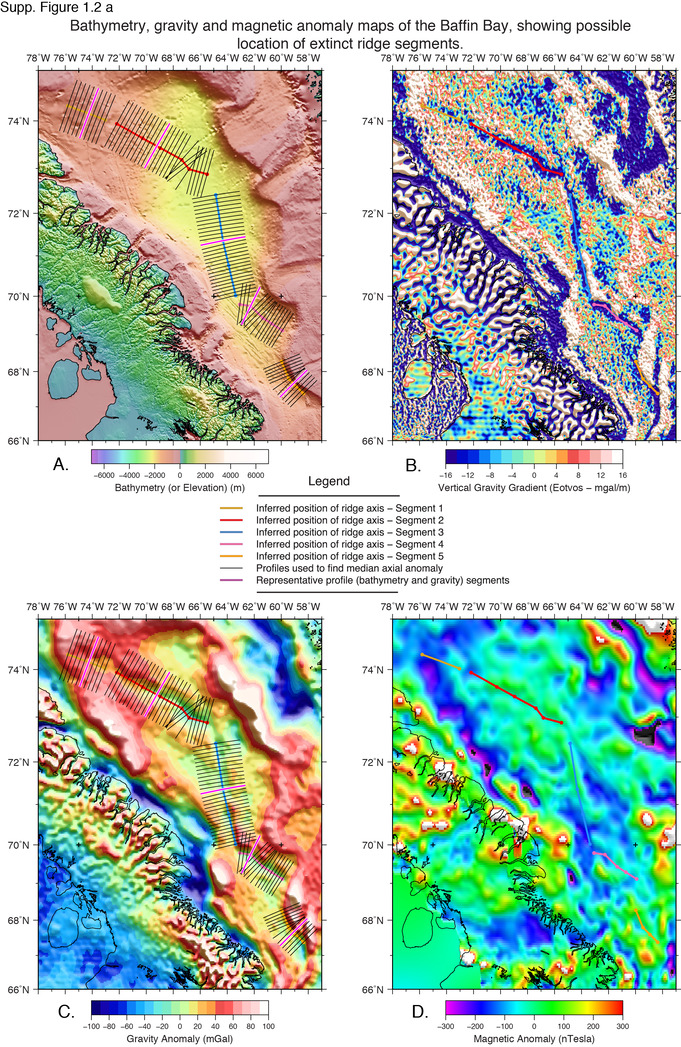| Ocean: | Marginal basin |
| Spreading center type: | Large-scale extinct MOR |
| Time of cessation: | Ca. 35 Ma, C13 (Jackson et al., 1979) |
| Subsequent active spreading center: | None in immediate region |
| Cessation style: | Gradual reduction in spreading rate (Jackson et al., 1979) |
| Later deformation/volcanism | None reported |
Jackson et al. (1979), reported on the findings of geophysical surveys that obtained magnetic, gravity and seismic refraction data that located the extinct spreading center in the Baffin Bay. They reported a gravity low at the ridge axis of around 20 mGals, with width 20 km, and noted that it was narrower in width than the anomaly observed at the Labrador and Aegir rifts (Jackson et al., 1979). The ridge is reported to have decreased in spreading rate over the final 15 Myrs of spreading and whilst unequivocal interpretation of the magnetic anomalies at the Bay’s margins are not possible, it is likely that the ridge was active between anomaly 21 and anomaly 13, and perhaps as early as anomaly 24 (Jackson et al., 1979). Jackson et al. (1979) observed that the ridge was likely to comprise multiple short segments and that opening was at an oblique angle to the spreading direction. They speculate that the crustal structure of the ridge, which is thicker to the north, may suggest late magmatic outpourings buried the axial valley that is visible in the south.
A detailed seismic reflection study was undertaken by Skaarup et al. (2006), which provided additional information regarding the early rifting of the basin and extension within the continental margins. They found that the ridge axis was strongly segmented and that the fracture zones defining this extend into the margins, with volcanism along the margin varying according to this segmentation. They gave two possible ages for commencement of spreading, at either chron 33n (80–74 Ma) or chron 27n (61.3–60.9 Ma) (Skaarup et al. 2006).
Jackson et al. (1979) note that both the Labrador and Baffin Bay extinct ridges are transposed against large transform faults to the north, which they feel may have significance for spreading cessation. The role of the Nares transform fault in the Baffin Bay is hotly disputed by Christopher et al. (2011), who argue that the Smith Sound at the southwest of Greenland represents continental crust and shows no evidence of displacement. They argue that extension was accommodated in the Lancaster Sound, which is situated between the Baffin and Devon Islands.
A gravity inversion using satellite data, and calibrated with seismic refraction studies from the region, has also been undertaken to model crustal thickness in the Baffin Bay and the direction of plate motions during opening and oceanic spreading (Hosseinpour et al., 2013). The results of Hosseinpour et al. (2013) suggested there was a long period of continental stretching in the Baffin Bay and Labrador Sea corridor and that onset of oceanic spread in the Baffin Bay was after 61 Ma (chron 26).
Christopher et al. (2011) argue that thickened continental crust presented a physical barrier to magmatic upwelling and extensional deformation and eventually led to the demise of this spreading center.
The extinct spreading center within Baffin Bay has thick sediment cover and a weak-gravity signal of ca. 20 mGals, which is significantly lower than better-defined extinct ridges of this study. Locating the axial segments in the east of the Baffin Bay is more difficult. This ridge was included in our study as a "well-defined" extinct ridge because it has an unambiguous origin as an extinct spreading center, and improved vertical gravity gradient grids have permitted adequate constraints on the the location of the former spreading center.
Christopher, T., Pulvertaft, R. and Dawes, P. R. 2011, North Atlantic spreading axes terminate in the continental cul-de-sacs of Baffin Bay and the Laptev Sea. Canadian Journal of Earth Science, v. 48, p. 593-601.
Hosseinpour, M., Müller, R. D., Williams, S. E., and Whittaker, J. M., 2013, Full-fit reconstruction of the Labrador Sea and Baffin Bay, Solid Earth, v. 4, p. 461-479.
Jackson, H. R., Keen, C. E., Falconer, R. K. H., Appleton, K. P., 1979, New geophysical evidence for sea-floor spreading in central Baffin Bay, Canadian Journal of Earth Sciences, v. 16, p. 2122–2135.
Skaarup, N., Jackson, H.R. and Oakey, G., 2006, Margin segmentation of Baffin Bay/Davis Strait, eastern Canada based on seismic reflection and potential field data, Marine and Petroleum Geology, v. 23, p. 127–144.


